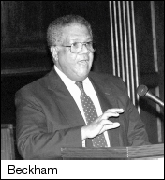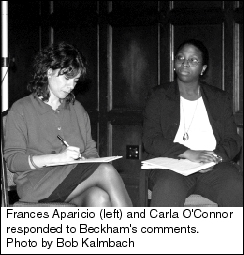The University Record, October 21, 1998
Beckham: Campus diversity must be ‘manifest in mission’
By Jane R. Elgass
 Campus diversity has become a professional field of practice, and one of the sites where it is best practiced is the U-M, according to Edgar Beckham. The U-M is one of few universities where campus diversity—not just the numbers—has become part of the fabric of the institution, he said.
Campus diversity has become a professional field of practice, and one of the sites where it is best practiced is the U-M, according to Edgar Beckham. The U-M is one of few universities where campus diversity—not just the numbers—has become part of the fabric of the institution, he said.
“Diversity is what colleges and universities do to realize democracy,” Beckham said last week. “It’s like building a library, however. It must be strategically managed.”
Beckham was program officer for culture and education at the Ford Foundation for eight years, and recently joined the Association of American Colleges and Universities and. He spoke Oct. 15 on “Diversity, Democracy and Educational Excellence” as part of the Distinguished Lecture Series of the Center for Community Service and Learning.
Beckham has been in charge of the Ford Foundation’s Diversity Initiative for the past eight years and in that time has seen the Foundation’s support of diversity efforts at institutions of higher education pay off in big benefits. The Foundation has allocated approximately $20 million in recent years “to encourage colleges and universities to value diversity as an asset and use it as a resource,” Beckham told his audience in the Kuenzel Room of the Michigan Union.
Foundation trustees, alarmed at the racial tensions on campuses in the early 1990s and fearful they might threaten gains already made, initially focused on funding faculty and development and curricular renewal projects through the Initiative, which Beckham characterized as the “quintessential engagement of diversity and democracy.”
The trustees “were aiming high,” Beckham noted, “focusing not on just improving race relations, but also on institutional transformation. They wanted diversity to become embedded in the mission and manifest in the policy” of the schools.
The institutional culture had to change to accomplish this, he explained. Since the faculty affect the curriculum the most, the focus was on the faculty.
“This was the beginning of the transformation of ‘diversity’ from a mere demographic descriptor, a way of characterizing a population, to a matter of educational urgency that would have to include the educational input that only the faculty can provide.”
A second round of funding focused on encouraging institutions to look at their history to see where they had been with respect to diversity, where they currently were and where they wanted to go, with an emphasis on broad-based institutional planning.
The third phase of funding was to intermediary groups, involving many more people and bringing 250 institutions into the network participating in Initiative programs.
While the Diversity Initiative has been very successful and essentially become a public information project, Beckham did caution about the tendency of institutions “to organize themselves in fiefdoms that are identified by special expertise,” turf areas that each have their own brand of status, privilege and power.
For campus diversity to be successful in all of its interpretations, “it must ramify into all domains of the institution,” he said. “The practitioners have to occupy all the turf.”
If practitioners are each assigned specific turfs, he explained, we run the risk of a narrow focus and the institutional influence is diminished.
The efforts must be multidisciplinary, he said, so the practitioners must be interdisciplinary and sensitive to others’ roles. “Both are part of the professional practice of campus diversity. This must be a shared enterprise.”
Beckham’s presentation was co-sponsored by the Office of the Provost, Horace H. Rackham School of Graduate Studies and the Association of American Colleges and Universities. The overall series is co-sponsored by the Office of the Vice President for Research, Undergraduate Research Opportunity Program and other U-M units.
Faculty members respond to Beckham’s comments
 Two faculty members responded to Edgar Beckham’s address on “Diversity, Democracy and Educational Excellence” last week.
Two faculty members responded to Edgar Beckham’s address on “Diversity, Democracy and Educational Excellence” last week.
Frances Aparicio, Arthur F. Thurnau Professor and associate professor of Spanish and of American culture, commented that she has been intrigued by the definitions of diversity at the University, particularly the way administrators recently have discussed the importance of diversity in the history of the U-M. “This is important in contesting the recent anti-affirmative action” lawsuits, she noted. “It gives diversity a broader scope and doesn’t segregate minorities in the discussion.”
Emphasizing also that campus diversity does not just mean numbers, she stressed “we have a long way to go,” with a particular challenge to look at the way diversity is seen as an asset for the dominant and a deficit for minorities.
Hiring scholars of color is seen by the University as an asset, she noted, but when it comes to tenure, it is a deficit. “It is still not valued. We still have rigid definitions for tenure.”
The “triangulation” of students, materials and teachers and the complex interaction of those elements was briefly outlined by Carla O’Connor, assistant professor of education.
Students’ demographic diversity is reinterpreted when they enter college, O’Connor explained, and the teacher has to account for this and design the pedagogy in response. The materials selected for a class, as well as who is teaching the class, also have a significant impact.
“How do I take into account who I am and what I am when I’m designing a class?” she asked. “How much do those factors influence my syllabus, choice of materials?
“This puts the instructor in a difficult position,” she said, “having to account for all of this around the matter of diversity.
“The institutions have to clearly attend to this triangulation to successfully do campus diversity.”
Commenting that he had learned something from each of his respondents, Beckham cited the book Thinking with History by Carl Schorske, in which the author talks about going beyond thinking “about” history to seeing oneself and others “in the flow of social time. Teachers need to learn to do this,” Beckham said.
You can always drop us a line:

